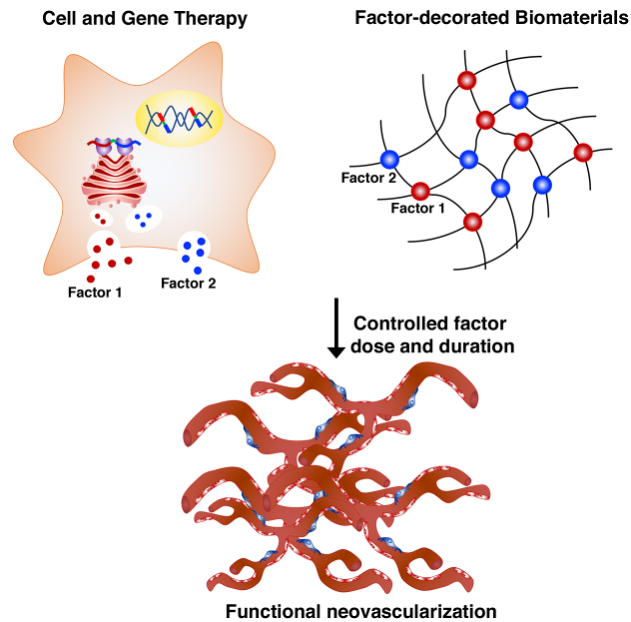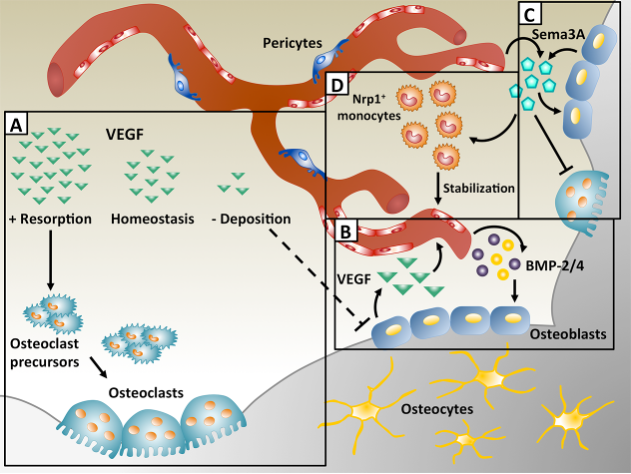Angiogenesis . Wound Healing . Bone Regeneration . Mesenchymal Stem Cells Gene Therapy. Cell therapy
Regenerative Angiogenesis
Therapeutic angiogenesis from vascular biology to regenerative medicine
Therapeutic angiogenesis aims at restoring blood flow to ischemic tissues by growing new vessels. Our research focuses on the basic mechanisms governing vascular growth and their translation into rational approaches to: 1) treat ischemic diseases and 2) improve the vascularization of tissue-engineered grafts.
Vascular endothelial growth factor (VEGF) is the master regulator of vascular growth. However, uncontrolled expression causes vascular tumors (angiomas). By the close interaction of basic scientists and clinical surgeons, we are developing novel methods to deliver VEGF alone or in combination with modulating factors to increase its safety and efficacy in vivo. Key approaches include: 1) transduced progenitors, combining the specific advantages of cell and gene therapy; 2) gene therapy vectors; and 3) engineered recombinant proteins to decorate smart biomaterials or endogenous tissue matrix (Fig. 1). Research is funded by Swiss agencies (SNF, Swiss Nanoscience Institute and Swiss Diabetes Foundation) and the European Union (FP7 and H2020).
Cellular and molecular mechanisms of VEGF-induced angiogenesis
Our understanding of angiogenic mechanisms is mostly based on developmental models, in which new vessels sprout to vascularize tissues. However, we found that VEGF delivery to skeletal muscle, at the doses needed for functional benefit, induces angiogenesis without sprouting, but by circumferential enlargement of vessels, followed by longitudinal splitting (“intussusception”, Gianni-Barrera 2020). The mechanisms regulating intussusceptive angiogenesis are essentially unknown and likely to differ from those of sprouting.
For example, the transition between normal and aberrant vascular growth during intussusceptive angiogenesis is not an intrinsic property of VEGF dose, but depends on the balance between VEGF-induced endothelial stimulation and vascular maturation mediated by pericyte recruitment by PDGF-BB (Gianni-Barrera 2018). The underlying molecular mechanism involves the activation of ephrinB2/EphB4 signaling between endothelium and pericytes, which finely tunes the degree of ERK1/2 activation downstream of VEGF-Receptor 2 and can be targeted pharmacologically (Groppa 2018).
Taking advantage of the highly controlled cell-based gene delivery platform we developed, we are currently pursuing a systematic investigation of the mechanisms that regulate intussusceptive angiogenesis in vivo through single-cell transcriptomics and non-invasive live imaging, to identify novel and more specific molecular targets for therapeutic angiogenesis.
Controlled factor delivery for therapeutic vascularization
We previously found that the transition between normal and aberrant angiogenesis depends on the VEGF amount in the microenvironment around each producing cell rather than on the total dose, since VEGF remains tightly localized in the extracellular matrix (Ozawa & Banfi 2004). In order to translate this biological concept into a clinically applicable approach, we developed a high-throughput FACS-based technology to rapidly purify transduced progenitors expressing specific VEGF levels (Misteli 2010). Controlled VEGF expression by FACS-purified progenitor populations could induce effective vascularization both inside and outside of thick, engineered cardiac patches (Marsano 2013; Boccardo & Gaudiello 2016), therapeutic angiogenesis in ischemic myocardium (Melly 2018) and increased in vivo vascularization of osteogenic grafts (Largo & Di Maggio 2020).
To avoid the need for genetic modification and improve clinical applicability, in collaboration with Jeffrey Hubbell (University of Chicago, USA) we developed a stateof-the-art biomaterial platform based on fibrin hydrogels that enables independent control of the dose and duration of release of matrix-bound growth factors, by which we could identify a 500-fold range of VEGF concentrations inducing only physiological capillary networks, which were long-term stable and therapeutically effective in ischemic wounds and osteogenic grafts (Sacchi 2014; D’Amico manuscript submitted; Burger & Grosso manuscript submitted).
Connection to Clinical Practice
Prof. Dr. Dirk J. Schäfer (Plastic and Reconstructive Surgery, University Hospital Basel)
Prof. Dr. Lorenz Gürke (Vascular Surgery, University Hospital Base)
Prof. Dr. Friedrich Eckstein (Cardiac Surgery, University Hospital Basel)
Therapeutic angiogenesis and tissue regeneration
We aim at translating the basic biological principles of functional vascular network formation into rational strategies to induce therapeutic growth of new blood vessels. We pursue this concept in 3 main areas of clinical interest:
1) Rapid and pervasive vascularization of the inner core of clinical-size osteogenic grafts, coupled with robust osteogenic differentiation of progenitors, for improved bone formation. We investigate the molecular cross-talk between angiogenesis and osteogenesis (Fig. 2) to generate bioactive microenvironments (Dr. M. Burger and Prof. D. J. Schäfer, Plastic and Reconstructive Surgery USB). Funding by the SNF Marie-Heim Vögtlin (to Dr. N. Di Maggio) and by the EU H2020 program (cmRNAbone and B2B).
2) Therapeutic angiogenesis in chronically ischemic muscle and non-healing wounds, especially in diabetic patients. Controlled delivery of recombinant angiogenic factors is achieved by smart biomaterials or by protein engineering for matrix super-affinity (PD Dr. E. Mujagic, PD Dr. T. Wolff and Prof. L. Gürke, Vascular Surgery USB). Funding by the EU FP7 Marie Curie program (AngioMatTrain) and Swiss Diabetes Foundation (Dr. R. Gianni-Barrera).
3) Therapeutic angiogenesis in the myocardium by controlled delivery of recombinant factors through decorated fibrin hydrogels, to treat cardiac ischemia (Dr. L. Melly PhD, Catholic University of Louvain and Prof. F. Eckstein, Cardiac Surgery USB). Funding by Swiss Nanoscience Institute (KOKORO).


